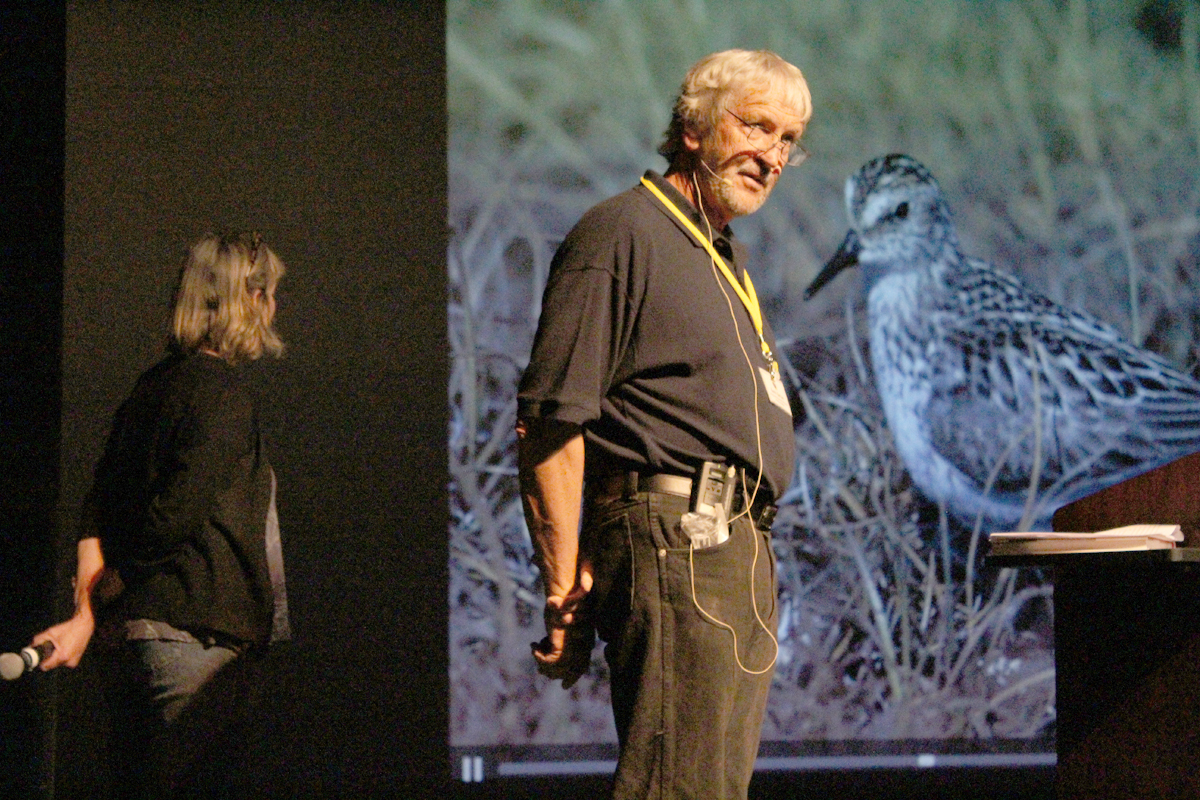Three notable birders bestowed their knowledge on eager listeners during the Shorebird Festival keynote speeches. Festival-goers from all over Alaska and the lower-48 gathered in the Mariner Theatre on the evening of Saturday, May 14 to hear from Sharon Stiteler, Kevin T. Karlson and Dale Rosselet.
Before the keynote speakers took the stage, Commissioner of the Alaska Department of Fish and Game Sam Cotten explained Kachemak Bay’s estuaries, shores, and tidal area designation as part of the Western Hemisphere Shorebird Reserve Network. Kachemak Bay has been designated as being of international importance, which means that there are at least 100,000 shorebirds, or 10 percent of the global population, present. Portions of the bay, including Fox River Flats, Mud Bay and Mariner Park Lagoon, have been WHSRN sites since 1994, according to a press release. Since then, however, it has been determined that the entirety of the bay plays an important ecological role for the shorebirds.
“This bay has been a part of my life for 40 years and I suspect there are a lot of people here that have been enjoying this part of the world a lot longer than that,” Cotten said. “I certainly have enjoyed the bounty of this bay and hope to continue to do so. The designation as part of this network recognizes Kachemak Bay and the people of this area in their role of maintaining a healthy ecosystem for thousands of shorebirds during their migration.”
Sharon Stiteler, who runs birding site Birdchick, gave the first keynote presentation, titled “1001 Secrets Every Birder Should Know.” Stitler also is the author of a book of the same name, as well as “Disapproving Rabbits” and “City Birds/Country Birds,” works as a national park ranger for the Mississippi National River and Recreation Area, and is a beekeeper. Stiteler began birding at age seven and has grown her childhood obsession into a career.
Despite its technical-sounding title, “1001 Secrets” was a humor-filled recounting of Stiteler’s bird-watching adventures – often with her husband Bill Stiteler, whom she refers to as “non-birding Bill.” The lengths to which she will go to see birds, especially lifers – birds one has not seen before – involve trekking through a nude beach in Florida and climbing the side of a volcano in Guatemala.
However, globe-trekking or intoxicated bird shenanigans are not required to be a successful birder. Birding is a treasure hunt that can be done anywhere, Stiteler said. Whether a person keeps a check list of every bird they come across, catalog birds with photos, or simply watch birds through a scope, there is no wrong way to bird.
“Enjoy birding however you want, as long as you’re not harming a species,” Stiteler said.
One of the birding challenges Stiteler faces, however, is the struggle of being married to a non-birder. When she brought home a bird drunk on fermented berries to have a safe place to sleep for the night, Stiteler said Bill’s first question when she mentioned she brought home a bird in her messenger bag was, “It is dead or alive?”
“He does not get the bird thing at all,” she said. “(One) point of contention in our marriage is how many dead birds I keep in our freezer.”
Stiteler explained after her speech that she uses the dead birds for a program about tracking in nature with the national parks, so she has proper permitting to keep the birds stored in her freezer. However this, and other birding related habits, such as a book collection with titles Bill deems odd, are among the struggle of a partner who does not relate to her passion.
Karlson and Rosselet, a married pair of birders, gave the second keynote speech of the evening. “Birds on the Wind,” used photos to tell the story of the scientific feat of bird migration, the beauty of birds, and the impact that humankind have on bird habitats.
“Any adventure worthwhile is not always joyous,” stated Karlson at the beginning of the presentation. The couple detailed their travels through a variety of weather conditions to see and photograph birds all over the country. In addition to taking in the beauty of the birds, Rosselet and Karlson also focus on the threats that people pose to bird populations.
“Less than half of the birds that migrate south of the tropic of Cancer return for the next breeding season,” Rosselet said. “Those other half die in their first calendar year due to a variety of reasons. It’s a really arduous time for them when they are migrating.”
For instance, they witnessed multiple dead birds that had been collected from just two city blocks in Chicago on morning.
“Birds crash into high rise buildings that leave their lights on all night and if you get a foggy night, these birds get attracted to the light, disoriented, and they crash into the windows,” Karlson said. “You want to know why our warblers are probably 50 percent of their numbers when I started 38 years ago, that’s a major reason.”
Rosselet and Karlson moved from the sobering to the spectacular throughout their presentation, all the while showing hundreds of photographs of birds they had taken over their 38 years of birding together. The couple also wrote a book together, “Birding by Impression,” which Rosselet described as a how-to guide to identifying birds.
The couple began birding after a college friend took them on an excursion, and then slowly got into it as they began their marriage. Rosselet has worked with the New Jersey Audobon Society since 1983 in nature education, while Karlson started out as a construction worker and then moved into wildlife photography and book authorship as a result of his love of birding.
“We never get bored, there’s always birds to look at and it enriches our lives,” Rosselet said.
Anna Frost can be reached at anna.frost@homernews.com.



